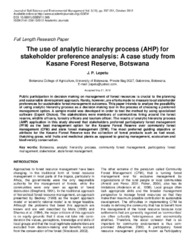The use of analytic hierarchy process (AHP) for stakeholder preference analysis: A case study from Kasane Forest Reserve, Botswana
Abstract
Public participation in decision making on management of forest resources is crucial to the planning and sustainable development approach. Rarely, however, are efforts made to measure local stakeholder preferences for sustainable forest management outcomes. This paper intends to analyse the possibility of using analytic hierarchy process as a decision-making tool in the process of choosing a preferred management option. A sample model was developed in order to test the method by using specialized software (Expert Choice). The stakeholders were members of communities living around the forest reserve, wildlife officers, forestry officers and tourism officer. The results of analytic hierarchy process (AHP) application in this study showed that stakeholders preferred participatory forest management (PFM) as the best management option for the Kasane Forest Reserve over community forest management (CFM) and state forest management (SFM). The most preferred guiding objective or attribute for the Kasane Forest Reserve was the collection of forest products such as fuel wood, thatching grass, wild fruits and medicinal plants as opposed to grazing management, ecotourism and biodiversity conservation.
URI
https://academicjournals.org/journal/JSSEM/article-full-text-pdf/50C41E910567.pdf10.5897/JSSEM11.065
${dspac:e.baseUrl}/handle/13049/341
Collections
- Research articles [88]

